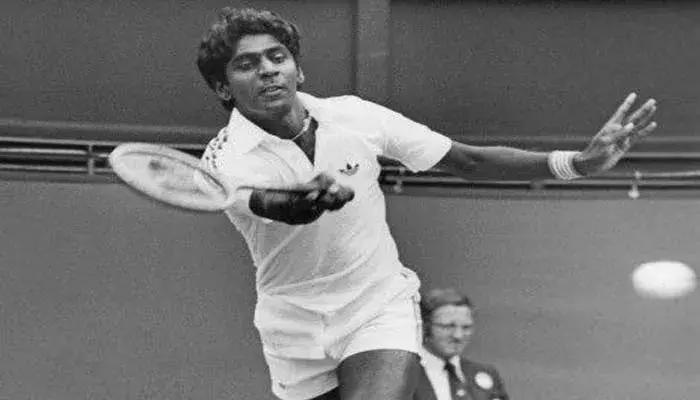A Teenagers Bold Decision
Vijay Amritraj was just 16 years old, when he took the plunge and turned pro

Just over half a century ago a talented 16-year-old tennis player from Madras (now Chennai) took a bold decision that had a major effect on his career and the future of Indian tennis. He turned pro.
It was a revolutionary move. Open tennis had come about only a couple of years before, with professionals allowed to play around the circuit along with amateurs. The pros had over the years been part of Jack Kramer's contracted professional tennis tours in the 50s and 60s. But they could not compete in the Grand Slam tournaments and in the Davis Cup.
This was the reason why Indian ace Ramanathan Krishnan did not turn pro despite an offer of a lucrative contract from Kramer in 1960 when he was one of the leading players in the world. In India, Wimbledon and Davis Cup are sacred to the tennis player and Krishnan took little time in turning down the offer.
Open tennis however changed all that. Rod Laver, a pro, won the inaugural Open Wimbledon in 1968 but Arthur Ashe notched up a major point for the amateurs by winning the US Open. However, by now open tennis was a fait accompli, the way ahead and Vijay Amritraj was quick to realise that. Just under 17 and representing India in junior competitions he decided to take the plunge and joined the professional ranks.
In a telephone conversation with me from Los Angeles where he is based Amritraj gave credit to his parents for backing his decision. "Everyone told them that there was no future in the move, that one cannot make a career from tennis, that Vijay should concentrate on his education'' he said, "but they backed me even if they were shooting for the stars, and shooting blind''.
It was certainly an unusual step for an Indian player, let alone for one so young. By 1970 Krishnan's career was over, and Jaideep Mukherjea and Premjit Lal were India's leading players. But Lal was 30 years old and Mukherjea was 28 years old, and they tread cautiously remaining amateurs even as they took part around the circuit with modest success while continuing to represent India in the Davis Cup.
Amritraj's move turned out to be a timely masterstroke. By the early 70s it was clear that the best playing days of Lal and Mukherjea were over and it was Vijay Amritraj and his brother Anand Amritraj who would carry India's hopes in the international arena.
But making the transition would need specialised training though he was strong on the basics thanks to Rama Rao's coaching in Madras. Here Vijay Amritraj was lucky in striking up a friendship with Pancho Gonzales some 25 years his senior. Gonzales had been world No 1 and a renowned player on Kramer's pro circuit. He was also a noted coach and agreed to train Vijay whom he saw as a potential world-beater.
Thanks to Gonzales' advanced coaching and his own prodigious talent Vijay Amritraj not only became the country's leading player by the early 70s, he also fared reasonably well around the international tennis circuit and played his first Wimbledon singles match in 1972.
His big breakthrough year was 1973 when he made it to the quarterfinals at both Wimbledon and the US Open and won three titles around the ATP Tour. By this time noted tennis writer Bud Collins was hailing the trio of Amritraj, Bjorn Borg and Jimmy Connors as the ABC of the game's next generation.
While Vijay Amritraj's on-court achievements might not rank alongside that of the other two it is still praiseworthy. A career best rank of world No 16, 16 ATP Tour singles titles, two more quarterfinal berths at the US Open in 1974 and Wimbledon in 1981, victories over all the top ranked players at one time or the other and leading India into the Davis Cup final in 1974 and 1987 are achievements to be proud of.
Moreover, Vijay Amritraj has spread his wings over a much wider canvas. For starters there was the setting up of the Britannia Amritraj tennis programme (BAT) in Madras to help unearth talent for the future of Indian tennis.
And the laurels that have come his way have been beyond the reach of most international sportsmen. He has been president of the ATP Player Council, has addressed the United Nations, been appointed by secretary general Kofi Annan as UN Messenger of Peace, awarded the prestigious Pierre Coubertin award by the UN in Paris
He was named as the Davis Cup Centennial ambassador by the International Tennis Federation, elected to honorary membership of the All England Lawn Tennis club at Wimbledon. He has had the privilege of carrying the Olympic torch at the Seoul Olympics, starting the Vijay Amritraj Foundation, an international charity organisation that raises awareness on issues of drugs and HIV/AIDS, raising funds to fight the spread of AIDS worldwide.
He was awarded the Padma Shri in 1983 for enhancing India's image overseas, and is a TV anchor/expert par excellence. How many other sportsmen anywhere in the world have received so many honours in such diverse fields? All this in a way has its genesis in the decision Vijay Amritraj took just over half a century ago.



